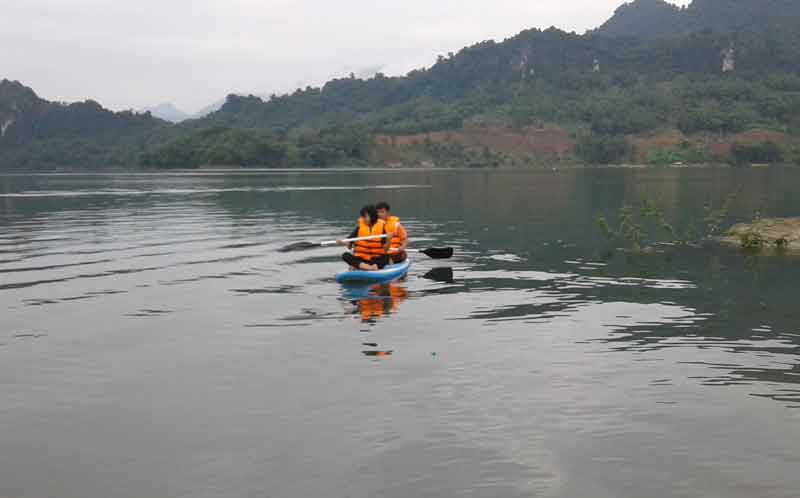
(HBO) - In early 2019, Tan Lac district received over 458.6 million VND (19,757 USD) from the non-governmental organisation Action on Poverty (AOP) to develop community-based tourism. So far, the project has been carried out in two communes - Phu Cuong and Nam Son (now Van Son commune), which helped create livelihoods and improve local incomes.
 Tourists
experience raft rowing at Ngoi village, Ngoi Hoa commune (now Suoi Hoa
commune), Tan Lac district.
Tourists
experience raft rowing at Ngoi village, Ngoi Hoa commune (now Suoi Hoa
commune), Tan Lac district.
The project provided local households with loans to renovate
their houses and necessary skills to engage in community tourism. It also
helped with the building of convenience stores in the locality. In late July
2019, the community-based tourism site in Chien hamlet, Nam Son commune, was officially
put into operation. Since then, it has attracted thousands of visitors.
Tan Lac district has so far lured 10 investment
projects in tourism. Five have been approved by the provincial People’s
Committee, while the remainders are being appraised.
Approved investment projects include the Hoa
Binh Lake resort and eco-tourism project worth over 800 billion VND (34.4
million USD) of Lac Hong Investment joint Stock Company; the eco-tourism area
and May valley nature reserve project worth over 130 billion VND of Hoa Binh
Clean Agriculture joint Stock Company; the Thung Khe spiritual and ecological
tourism project worth nearly 300 billion VND of Cat Tuong Thien joint Stock
Company; the Ngoi Hoa ecotourism project worth 474 billion VND of Hoang Son
Investment Power Construction Trade joint Stock Company; and the V’Star-Ngoi
Hoa ecotourism project worth 125 billion VND of V’Star joint Stock Company.
Projects pending approval include the Ngoi Hoa ecotourism
project invested by Hoshi Vietnam group, the forest protection in combination
with tourism project by Gia Ngan joint Stock Company, the Muong ethnic cultural
and tourism project in Ngoi village by Hoa Binh Tourism-Investment Company, the
Ho Guon-Song Da ecotourism project by Ho Guom group, and the Dao Hoa valley
ecotourism project by the Hoa Binh Clean Agriculture joint Stock Company.
The district has been actively calling for
investment in tourism. Besides implementing well the State management in
tourism and improving human resources, the locality has intensified
communications to raise public awareness of tourism development.
Tourism in Tan Lac is expected to become a
spearhead economic sector in the coming time. In 2019, the district welcomed 130,658
visitors, up 24,192 compared to 2018. Of the figure, more than 4,500 were
foreigners. The tourism sector grossed over 45 billion VND (1.9 million USD) in
revenue, surpassing the yearly target by 0.6 percent./.
A diverse chain of eco-tourism and resort destinations concentrated in Hoa Binh city and the districts of Tan Lac, Da Bac, and Luong Son… Along with the launch of several key high-quality resort tourism projects, these developments have reshaped the landscape and enhanced the appeal of Hoa Binh as a travel destination.
Boasting diverse terrain, a mild climate, and rich natural resources, Cao Phong district is increasingly asserting its place on Vietnam’s tourism map, attracting both domestic and foreign visitors. The district is renowned for its stunning landscapes, majestic mountains, a crystal-clear hydropower lake, and the unique cultural identity of local ethnic groups.
With its pristine landscapes, unique cultural heritage of Muong ethnic minority, and an expanding range of visitor experiences, Tan Lac district of Hoa Binh has fast become a captivating destination for both domestic and international tourists.
Until now, Sung village in Cao Son commune, Da Bac district remains the only Dao ethnic community in Hoa Binh province to develop a community-based tourism model. Beyond its untouched natural landscapes, cultural identity serves as the cornerstone attraction for visitors.
Alongside the diverse cultural identities of the Kinh, Muong, Tay, Thai, Dao, and Mong ethnic people, Hoa Binh province is also renowned as the "capital" of the northwestern Vietnamese cuisine, offering unique and distinctive dishes. At festivals, during Lunar New Year (Tet), or on significant family or community occasions, special dishes are prepared, leaving a lasting impression on visitors.
A Phong Linh (Yellow Tabebuia) flower garden in Thang village, Thach Yen commune, Cao Phong district is currently in full bloom, drawing a large number of visitors.



 Tourists
experience raft rowing at Ngoi village, Ngoi Hoa commune (now Suoi Hoa
commune), Tan Lac district.
Tourists
experience raft rowing at Ngoi village, Ngoi Hoa commune (now Suoi Hoa
commune), Tan Lac district.